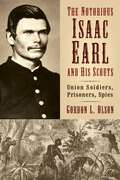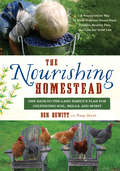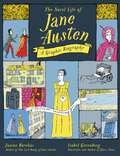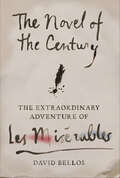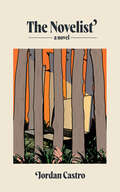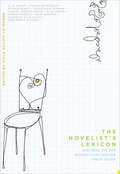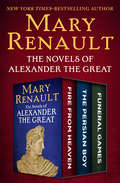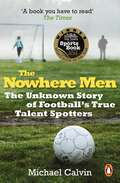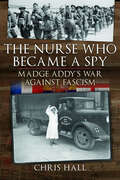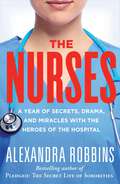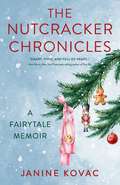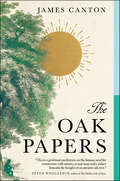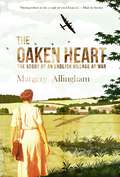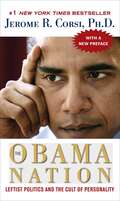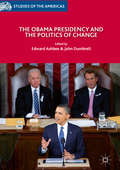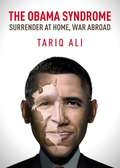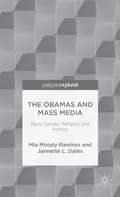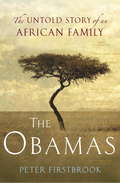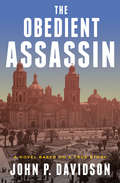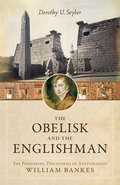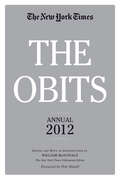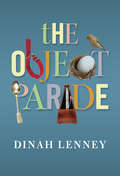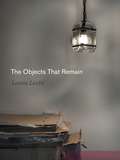- Table View
- List View
The Notorious Isaac Earl and His Scouts: Union Soldiers, Prisoners, Spies
by Gordon L. OlsonWhile large armies engaged in epic battles in the eastern theater of the Civil War, a largely unchronicled story was unfolding along the Mississippi River. Thirty "Special Scouts" under the command of Lieutenant Isaac Newton Earl patrolled the river, gathering information about Confederate troop activity, arresting Rebel smugglers and guerillas, and opposing anti-Union insurrection. Gordon Olson gives this special unit full book-length treatment for the first time in The Notorious Isaac Earl and His Scouts. Olson uses new research in assembling his detailed yet very readable account of Earl, a dynamic leader who rose quickly through Union Army ranks to command this elite group. He himself was captured by the Confederates three times and escaped three times, and he developed a strategic -- and later romantic -- relationship with a Southern woman, Jane O'Neal, who became one of his spies. In keeping the river open for Union Army movement of men and supplies to New Orleans, Earl's Scouts played an important, heretofore unheralded, role in the Union's war effort.
The Nourishing Homestead
by Ben Hewitt Penny HewittA practiculture way to grow nutrient-dense food, produce healthy fats, and live the good life The Nourishing Homestead tells the story of how we can create truly satisfying, permanent, nourished relationships to the land, nature, and one another. The Hewitts offer practical ways to grow nutrient-dense food on a small plot of land, and think about your farm, homestead, or home as an ecosystem. Much of what the Hewitts have come to understand and embrace about their lives of deep nourishment is informed by their particular piece of land and local community in northern Vermont, but what they have gleaned is readily transferable to any place--whether you live on 4 acres, 40 acres, or in a 400-square-foot studio apartment. Ben and Penny (and their two sons) maintain copious gardens, dozens of fruit and nut trees and other perennial plantings, as well as a pick-your-own blueberry patch. In addition to these cultivated food crops, they also forage for wild edibles, process their own meat, make their own butter, and ferment, dry, and can their own vegetables. Their focus is to produce nutrient-dense foods from vibrant, mineralized soils for themselves and their immediate community. They are also committed to sharing the traditional skills that support their family, helping them be self-sufficient and thrive in these uncertain times. Much of what the Hewitts are attempting on their homestead is to close the gaps that economic separation has created in our health, spirit, and skills. Ben uses the term "practiculture" to describe his family's work with the land--a term that encompasses the many practical life skills and philosophies they embody to create a thriving homestead, including raw-milk production, soil remediation, wildcrafting, Weston A. Price principles, bionutrient-dense farming, permaculture, agroforestry, traditional Vermont hill farming, and more. The Nourishing Homestead also includes information on deep nutrition, the importance of good fats, and integrating children into the work of a homestead. The Hewitts' story is reminiscent of The Good Life, by Helen and Scott Nearing, and is sure to inspire a new generation of homesteaders, or anyone seeking a simpler way of life and a deeper connection to the world.
The Novel Life of Jane Austen: A Graphic Biography
by Janine Barchas'Stunning. Gobsmacking. Groundbreaking. What a gift to Austen fans the world over!' - Natalie Jenner, author of The Jane Austen Society, Bloomsbury Girls & Every Time We Say GoodbyeThe Novel Life of Jane Austen is a beautifully illustrated graphic biography that brings to life the remarkable story of one of Britain's most beloved literary icons. Through vivid artwork and compelling narrative, readers are invited to journey alongside Jane Austen as she navigates the challenges and triumphs that shaped her works. Told in three parts (Budding Writer 1796-1797; Struggling Artist 1801-1809; Published Author 1809-1817), the gritty circumstances of Austen's own genteel poverty and the small daily injustices so often borne by creative women at this time, are shown against the backdrop of Georgian England and reflect many of the plots and characters woven into Austen's greatest works. All the settings and scenarios presented are based upon the historical record, including the clothing, architecture, decor and Regency locations. Sprinkled throughout, the Easter eggs and witty references to popular screen adaptations of Austen's novels will satisfy the casual and avid Austen fan alike.A fantastic collaboration between renowned Austen expert, Janine Barchas, and bestselling graphic novelist Isabel Greenberg, this is a one-of-a-kind, impeccably researched rendition of the author's life.
The Novel of the Century: The Extraordinary Adventure of Les Misérables
by David BellosA New York Times Book Review Editors' Choice Winner of the American Library in Paris Book Award, 2017Les Misérables is among the most popular and enduring novels ever written. Like Inspector Javert’s dogged pursuit of Jean Valjean, its appeal has never waned, but only grown broader in its one-hundred-and-fifty-year life. Whether we encounter Victor Hugo’s story on the page, onstage, or on-screen, Les Misérables continues to captivate while also, perhaps unexpectedly, speaking to contemporary concerns. In The Novel of the Century, the acclaimed scholar and translator David Bellos tells us why.This enchanting biography of a classic of world literature is written for “Les Mis” fanatics and novices alike. Casting decades of scholarship into accessible narrative form, Bellos brings to life the extraordinary story of how Victor Hugo managed to write his novel of the downtrodden despite a revolution, a coup d’état, and political exile; how he pulled off a pathbreaking deal to get it published; and how his approach to the “social question” would define his era’s moral imagination. More than an ode to Hugo’s masterpiece, The Novel of the Century also shows that what Les Misérables has to say about poverty, history, and revolution is full of meaning today.
The Novelist: A Novel
by Jordan CastroBrisk and shockingly witty, exuberantly scatological as well as deeply wise, The Novelist is a delight. Jordan Castro is a rare new talent: an author highly attuned to the traditions he is working within while also offering a refreshingly fun sendup of life beset by the endless scroll. —Mary South, author of You Will Never Be ForgottenIn Jordan Castro&’s inventive, funny, and surprisingly tender first novel, we follow a young man over the course of a single morning as he tries and fails to write an autobiographical novel, finding himself instead drawn into the infinite spaces of Twitter, quotidian rituals, and his own mind. The act of making coffee prompts a reflection on the limits of self-knowledge; an editor&’s embarrassing tweet sparks rage at the literary establishment; a meditation on first person versus third examines choice and action; an Instagram post about the ethics of having children triggers mimetic rivalry; the act of doing the dishes is at once ordinary and profound: one of the many small commitments that make up a life of stability. The Novelist: A Novel pays tribute to Nicholson Baker&’s The Mezzanine and Thomas Bernhard&’s Woodcutters, but in the end is a wholly original novel about language and consciousness, the internet and social media, and addiction and recovery.
The Novelist’s Lexicon: Writers on the Words That Define Their Work
by Villa Gillet Le MondeAt the renowned, international literary conference hosted by Villa Gillet and Le Monde, organizers asked more than seventy prominent authors to choose a word that opens a door to their work. Their musings, collected here for the first time, offer an extraordinary portrait of writing and reading from the novelist's perspective. Organized alphabetically by keyword, the anthology is filled with intriguing, amusing, and often surprising insight, essential to an intimate understanding of literature. Through these personal "passwords," authors articulate the function of language, character, plot, and structure. Throughout the process, they reveal their relationship to the elements of story. Jonathan Lethem discusses the necessity of "furniture" in the novel. A. S. Byatt describes the power of the narrative web. Colum McCann details the benefits of anonymity. Daniel Mendelsohn expounds on the unknowable, or what the author should or should not impart to the reader. Etgar Keret explains the importance of balagan, a Hebrew word meaning "total chaos," and Annie Proulx clarifies terroir, which embodies the complexities of time, place, geography, weather, and climate. Other participants include Rick Moody on adumbrated, Upamanyu Chatterjee on the bildungsroman, Enrique Vila-Matas on discipline, Adam Thirwell on hedonism, Nuruddin Farah on identities, Andre Brink on the heretic, and Péter Esterhazy on the power and potential of words, words, words.
The Novels of Alexander the Great: Fire from Heaven, The Persian Boy, and Funeral Games (The Novels of Alexander the Great #2)
by Mary RenaultA New York Times–bestselling trilogy about the ancient Greek kingdom of Macedon and its leader from an author hailed by Hilary Mantel as &“a shining light.&” Fire from Heaven is a gripping account of the formative years of Alexander&’s life. The story tells of his complex relationship with his parents; of his two great bonds—to his horse, Oxhead, and to his dearest friend and eventual lover, Hephaistion—and of the army he commands when he is barely an adult. Coming of age during the battles for southern Greece, Alexander the Great first takes someone&’s life at age twelve and swiftly eliminates his rivals as soon as he comes to power, emerging in this novel as a captivating and complex figure. The iconic Persian Boy centers on the Macedon king as seen through the eyes of his lover and most faithful attendant, the eunuch Bagoas. When Bagoas is very young, his father is murdered and he is sold as a slave to King Darius of Persia. Then, when Alexander conquers the land, he is given Bagoas as a gift, and the boy is besotted. This passion comes at a time when much is at stake—Alexander has two wives, conflicts are ablaze, and plots on his life abound. The result is a riveting account of a great conqueror&’s years of triumph and, ultimately, heartbreak. In Funeral Games, a bloody struggle for power rages after the death ofAlexander, leaving an empire that extends from the Adriatic Sea to the Indus River. The power players include Ptolemy, two father-son teams, and a cadre of influential women—not least of whom is Eurydike, whose plan is to marry Alexander&’s disabled brother, Arridaios. Brimming with outsize personalities, brazen plots, and a sweeping sense of history, Funeral Games brings to vivid life the world of Alexander the Great, and the seismic tumult in the wake of his death. This ebook features an illustrated biography of Mary Renault including rare images of the author. &“Mary Renault is a shining light to both historical novelists and their readers. She does not pretend the past is like the present, or that the people of ancient Greece were just like us. She shows us their strangeness; discerning, sure-footed, challenging our values, piquing our curiosity, she leads us through an alien landscape that moves and delights us.&” —Hilary Mantel
The Nowhere Men
by Michael CalvinWinner of The Times British Sports Book Award 2014. A fascinating insight into the enclosed world of football scouts in the UKA teenaged boy plays football in a suburban park. His name is Raheem Sterling. The call is made: “Get down here quick. This is something special”.Another boy is 8, going on 28. His name is Jack Wilshere. The referee, an Arsenal scout, spirits him away from Luton Town.A young goalkeeper struggles on loan at Cheltenham Town in League Two. His name is Jack Butland. Within months he will be playing for England.Welcome to football’s hidden tribe. Scouts are everywhere yet nowhere, faceless and nameless, despite making the informed decisions worth millions. Award-winning sportswriter Michael Calvin opens up their hidden world, examining their disconnected lifestyles, petty betrayals and unconsidered professionalism of men who spend long, lonely hours on the road.
The Nurse Who Became a Spy: Madge Addy's War Against Fascism
by Chris HallThe life story of Madge Addy, a working-class Manchester woman who volunteered to fight Fascism and Nazism in two major wars, is a truly remarkable one. Madge left her job and her husband to serve in the Spanish Civil War as a nurse with the Republican medical services. In Spain she was wounded in a bombing raid, fell in love with another foreign volunteer who became her second husband, was made a Prisoner of War and was the last British nurse to leave Spain, witnessing the horrors of Franco’s Fascist regime before she left. She was caught up in the ‘Fall of France’ and lived in Marseille with her Norwegian husband. From 1940 to 1944 Madge was first an amateur resister and later a full-time secret agent, working with the likes of Ian Garrow, Pat O’Leary and Guido Zembsch-Schreve. She also acted as a courier, flying to Lisbon to deliver and receive secret messages from British intelligence. She also became romantically involved with a Danish secret agent and married him after the war. Madge’s wartime achievements were recognised by the British with the award of an OBE and by the French with the award of the Croix de Guerre. Chris Hall brings Madge’s story to life using archive material and photographs from Britain, France, Spain and Norway. Madge’s Spanish Civil War experiences are vividly described in a mass of letters she wrote requesting medical aid and describing the harrowing conditions at her wartime hospital. Her activities in the Second World War show a woman with ‘nerves of steel’ and a bravery at times bordering on recklessness. As she herself said, ‘I believe in taking the war into the enemy camp’.
The Nurses: A Year of Secrets, Drama, and Miracles with the Heroes of the Hospital
by Alexandra RobbinsA New York Times bestseller. “A funny, intimate, and often jaw-dropping account of life behind the scenes.”—PeopleNurses is the compelling story of the year in the life of four nurses, and the drama, unsung heroism, and unique sisterhood of nursing—one of the world’s most important professions (nurses save lives every day), and one of the world’s most dangerous, filled with violence, trauma, and PTSD. In following four nurses, Alexandra Robbins creates sympathetic characters while diving deep into their world of controlled chaos. It’s a world of hazing—“nurses eat their young.” Sex—not exactly like on TV, but surprising just the same. Drug abuse—disproportionately a problem among the best and the brightest, and a constant temptation. And bullying—by peers, by patients, by hospital bureaucrats, and especially by doctors, an epidemic described as lurking in the “shadowy, dark corners of our profession.” The result is a page-turning, shocking look at our health-care system.
The Nutcracker Chronicles: A Fairytale Memoir
by Janine KovacPerfect for The Nutcracker holiday market and fans of work/life balance books, this memoir of a ballet dancer–turned–literary curator shares the real-life journey of a dancer, wife, and mother.The Nutcracker Chronicles, a modern twist on the beloved holiday ballet, intertwines the story of Clara and her nutcracker prince with the true-life stories that unfold backstage. The curtain rises on Ballet El Paso&’s production of The Nutcracker, where young Janine Kovac is cast as Fritz, the boy who breaks the nutcracker. Her director is Ingeborg Heuser, a German woman who once performed for Hitler and who peppers her teaching with insults like, &“Why can&’t you just dance like a pretty girl?&” At least it&’s better than &“You look like a cow on ice skates,&” which is what the other girls hear daily. Onstage, Janine wins the battle and embarks on a voyage through a snowy forest to the Land of the Sweets, where she serves as spectator to a beautiful dance. She also travels offstage, leaving El Paso to study at San Francisco Ballet before landing a job in Iceland and returning to California, where she rises through the ranks from soldier to snowflake to candy soloist. Eventually, however, she is relegated to watching other people dance—her husband, her children, her students—and her claim to the spotlight is replaced by the quest to find joy in her new roles.
The Némirovsky Question: The Life, Death, and Legacy of a Jewish Writer in Twentieth-Century France
by Susan Rubin SuleimanIrène Némirovsky succeeded in creating a brilliant career as a novelist in the 1930s, only to have her life cut short: a “foreign Jew” in France, she was deported in 1942 and died in Auschwitz. But her two young daughters survived, and as adults they brought their mother back to life. In 2004, Suite française, Némirovsky’s posthumous novel, became an international best seller; some critics, however, condemned her as a “self-hating Jew” whose earlier works were rife with anti-Semitic stereotypes. Informed by personal interviews with Némirovsky’s descendants and others, as well as by extensive archival research, this wide-ranging intellectual biography situates Némirovsky in the literary and political climate of interwar France and recounts, for the first time, the postwar lives of her daughters. Némirovsky's Jewish works, Suleiman argues, should be read as explorations of the conflicted identities that shaped the lives of secular Jews in twentieth-century Europe and beyond.
The Oak Papers
by James Canton"A profound meditation on the human need for connection with nature, as one man seeks solace beneath the bows of an ancient oak tree."—Peter Wohlleben, author of The Hidden Life of Trees"James Canton knows so much, writes so well and understands so deeply about the true forest magic and the important place these trees have in it. Knowledge and joy."— Sara Maitland, author of How to Be AloneJoining the ranks of The Hidden Life of Trees and H is for Hawk, an evocative memoir and ode to one of the most majestic living things on earth—the oak tree—probing the mysteries of nature and the healing role it plays in our lives.Thrown into turmoil by the end of his long-term relationship, Professor James Canton spent two years meditating [PA1]beneath the welcoming shelter of the massive 800-year-old Honywood Oak tree in North Essex, England. While considering the direction of his own life, he began to contemplate the existence of this colossus tree. Standing in England for centuries, the oak would have been a sapling when the Magna Carta was signed in 1215.In this beautiful, transportive book, Canton tells the story of this tree in its ecological, spiritual, literary, and historical contexts, using it as a prism to see his own life and human history. The Oak Papers is a reflection on change and transformation, and the role nature has played in sustaining and redeeming us. Canton examines our long-standing dependency on the oak, and how that has developed and morphed into myth and legend. We no longer need these sturdy trees to build our houses and boats, to fuel our fires, or to grind their acorns into flour in times of famine. What purpose, then, do they serve in our world today? Are these miracles of nature no longer necessary to our lives? What can they offer us? Taking inspiration from the literary world—Henry David Thoreau, Leo Tolstoy, Katherine Basford’s Green Man, Thomas Hardy, William Shakespeare, and others—Canton ponders the wondrous magic of nature and the threats its faces, from human development to climate change, implores us to act as responsible stewards to conserve what is precious, and reminds us of the lessons we can learn from the world around us, if only we slow down enough to listen.
The Oaken Heart: The Story of an English Village at War
by Margery AllinghamWorld War II on the home front: &“Fans of The Guernsey Literary and Potato Peel Pie Society or James Herriot will enjoy this unique historical account.&” —Library Journal This remarkable firsthand account—from the acclaimed Golden Age mystery author—was written to let people know how the Second World War affected ordinary English country people. The Oaken Heart is Margery Allingham&’s tribute to the resiliency and determination of the people of Tolleshunt D&’Arcy, the Essex village where she lived and nicknamed &“Auburn&” in her manuscript. Allingham, already a successful mystery author in 1939, was at work on the Albert Campion novel Traitor&’s Purse. The first hint of war was felt in the alarm of a radio announcer&’s voice, and Allingham put down her pen as her peaceful corner of the world braced for sending its men into battle, and even possible invasion. As villagers rallied around the cause—supporting each other and their country—Allingham found herself acting as the local billeting officer and first aid organizer. She writes of the sacrifices of farmers, the mistrust of politics, the grim acceptance of rationing, the bombing of London. And through it all, the never-ending hope for peace. The Oaken Heart captures the personal and universal toll of war, far from the front lines, written by a woman whose own quest for justice jumped from the page to the streets where she lived. &“Engrossing and moving.&” —Kirkus Reviews &“Her record of the events and people of this fraught wartime period is rendered with the skill found in the best of her fictional writing . . . remains an insight into another facet of a remarkable talent.&” —Crime Time
The Obama Nation: Leftist Politics and the Cult of Personality
by Jerome R. CorsiIn this thoroughly researched and documented book, the #1 New York Times bestselling co-author of Unfit for Command: Swift Boat Veterans Speak Out Against John Kerry explains why the extreme leftism of an Obama presidency would leave the United States weakened, diminished and divided, why Obama must be defeated -- and how he can be. Barack Obama stepped onto the national political stage when the then-Illinois State senator addressed the 2004 Democratic National Convention. Soon after Obama was elected to the U. S. Senate, author Jerome Corsi began researching Obama's personal and political background. Scrupulously sourced with more than 600 footnotes, The Obama Nation is the result of that research. By tracing Obama's career and influences from his early years in Hawaii and Indonesia, the beginnings of his political career in Chicago, his voting record in the Illinois legislature, his religious training and his adoption of Christianity through to his recent involvement in Kenyan politics, his political advisors and fundraising associates and his meteoric campaign for president, Jerome Corsi shows that an Obama presidency would, in his words, be "a repeat of the failed extremist politics that have characterized and plagued Democratic Party politics since the late 1960s. "In this stunning and comprehensive new book, the reader will learn about: Obama's extensive connections with Islam and radical politics, from his father and step-father's Islamic backgrounds, to his Communist and socialist mentors in Hawaii and Chicago, to his long-term and close associations with former Weather Underground heroes William Ayers and Bernadette Dohrn -- associations much closer than heretofore revealed by the press. Barack and Michelle's 20-year-long religious affiliation with the black-liberation theology of former Trinity United Church of Christ Reverend Jeremiah Wright, whose sermons have always been steeped in a rage first expressed by Franz Fanon , Stokely Carmichael and Malcolm X, a rage that Corsi shows has deep meaning for Obama. Obama's continuing connections with Kenya, the homeland of his father, through his support for the candidacy of Raila Odinga, the radical socialist presidential contender who came to power amid Islamist violence and church burnings. Obama's involvement in the slum-landlord empire of the Chicago political fixer Tony Rezko, who helped to bankroll Obama's initial campaigns and to purchase of Barack and Michelle's dream-home property. The background and techniques of the Obama campaign's cult of personality, including the derivation of the words "hope" and change." Obama's far-left domestic policy, his controversial votes on abortion, his history of opposition to the Second Amendment, his determination to raise capital-gains taxes, his impractical plan to achieve universal health care, and his radical plan to tax Americans to fund a global-poverty-reduction program. Obama's naïve, anti-war, anti-nuclear foreign-policy, predicated on the reduction of the military, the eradication of nuclear weapons and an overconfidence in the power of his personality, as if belief in change alone could somehow transform international politics, achieve nuclear-weapons disarmament and withdrawal from Iraq without adverse consequences, for us, for the Iraqis or for Israel. Meticulously researched and documented, The Obama Nation is the definitive source for information on why and how Barack Obama must be defeated -- not by invective and general attacks, but by detailed arguments that are well-researched and fact-based.
The Obama Presidency and the Politics of Change
by Edward Ashbee John DumbrellThis edited volume considers the extent to which the Obama presidency matched the promises of hope and change that were held out in the 2008 election. Contributors assess the character of "change" and, within this context, survey the extent to which there was enduring change within particular policy areas, both domestic and foreign. The authors combine empirical detail with more speculative assessment of the limits and possibilities of change amidst a very dense institutional landscape and in an era of intense political polarization. Some see significant changes, the full consequences of which may only be evident in later years. Other authors in the collection present a markedly different picture and suggest that processes of change were not only limited and partial but at times leading the US in directions far removed from the promises of 2008. The book will make an important contribution to the debates about the Obama legacy.
The Obama Syndrome: Surrender at Home, War Abroad
by Tariq Ali"In Cairo, at West Point, at Oslo, Obama has treated the world to one uplifting homily after another, each address larded with every euphemism that White House speechwriters can muster to describe America's glowing mission in the world: 'Our country has borne a special burden in global affairs'; 'Our cause is just, our resolve unwavering. ' The model for this variant of imperial presidency is Woodrow Wilson-no less pious a Christian, whose every second word was peace, democracy or self-determination, while his armies invaded Mexico, occupied Haiti and attacked Russia. But can't still goes a long way to satisfy those who yearn for it. . . " Book jacket.
The Obamas And Mass Media
by Mia Moody-Ramirez Jannette L. DatesUsing the cultural prism of race, this book critically examines the image of African Americans in media of the twenty-first century. Further, the authors assess the ways in which media focused on gender, religion, and politics in framing perceptions of the President and First Lady of the United States during the Obama administration.
The Obamas: The Untold Story of an African Family
by Peter FirstbrookOn January 20, 2009, a few hundred men, women, and children gathered under trees in the twilight at K#x19;obama, a village on the shores of Lake Victoria in western Kenya. Barack Obama#x19;s rise to the American presidency had captivated people around the world, but members of this gathering took a special pride in the swearing in of America#x19;s first black president, for they were all Obamas, all the president#x19;s direct African family. In the first in-depth history of the Obama family, Peter Firstbrook recounts a journey that starts in a mud hut by the White Nile and ends seven centuries later in the White House. Interweaving oral history and tribal lore, interviews with Obama family members and other Kenyans, the writings of Kenyan historians, and original genealogical research, Firstbrook sets the fascinating story of the president#x19;s family against the background of Kenya#x19;s rich culture and complex history. He tells the story of farmers and fishermen, of healers and hunters, of families lost and found, establishing for the first time the early ancestry of the Obamas. From the tribe#x19;s cradleland in southern Sudan, he follows the family generation by generation, tracing the paths of the famous Luo warriors-Obama#x19;s direct ancestors-and vividly illuminating Luo politics, society, and traditions. Firstbrook also brings to life the impact of English colonization in Africa through the eyes of President Obama#x19;s grandfather Onyango. An ambitious and disciplined man who fought in two world wars, witnessed the bloody Mau Mau insurrection, and saw his country gain independence from white rule, Onyango was also hot-tempered and autocratic: family lore has it that President Obama#x19;s grandmother abandoned the family after Onyango attempted to murder her. And Firstbrook delves into the troubled life of Obama#x19;s father, a promising young man whose aspirations were stymied by post-independence tribal politics and a rash tendency toward self-destruction-two factors that his family believes contributed to his death in 1982. They say it was no accident, as described in the president#x19;s memoirs, but rather a politically motivated hit job. More than a tale of love and war, hardship and hard-won success, The Obamas reveals a family history-epic in scope yet intimate in feel-that is truly without precedent.
The Obedient Assassin: A Novel Based on a True Story
by John P. DavidsonA dark and riveting thriller that reimagines the life and mission of the Spanish nationalist enlisted to murder Leon Trotsky: Based on a true chapter of world history and ten years of research, here is the story of the real-life reluctant soldier and killer, Ramón Mercader—the obedient assassinRamón Mercader was plucked from the front of the Spanish Civil War by the Soviets and conscripted to murder the great intellectual Leon Trotsky, a leader of the Bolshevik Revolution who was exiled in the 1920s for opposing Joseph Stalin.As Ramón is trained for the task and assumes a new identity, he lives a lush life in Paris, befriending Frida Kahlo and other artists of the time. He falls in love with a left-leaning Jewish woman whom he is ordered to seduce as a means of getting at Trotsky.From Barcelona to Paris and New York to Mexico City, the group controlling Ramón—including Ramón&’s mother and her lover—guides the assassin on the inevitable resolution of his grim task as he must penetrate Trotsky&’s compound.
The Obelisk and the Englishman
by Dorothy U. SeylerWilliam John Bankes (1786-1855) was a pioneer in the nascent study of the language, history, and civilization of ancient Egypt. At the Abydos Temple he discovered the King List -- a wall of cartouches listing Egyptian kings in chronological order -- which was vital to the decoding of Egyptian hieroglyphs. At Philae he uncovered a fallen obelisk, which he arranged to be transported back to England. And in modern-day Jordan he was the first European to make sketches and site plans of the "lost" city of Petra.Bankes's life was rich and full, and his discoveries have proven to be quite valuable and influential. But, living in an era when homosexuality was a capital offense, he was persecuted for being gay and threatened with imprisonment and execution. His decision to travel and pursue his love of art and architecture went against his father's wishes that he follow in his footsteps and become a politician. Despite such obstacles, Bankes's pioneering work on ancient temples and artifacts now enriches the knowledge of modern Egyptologists, and his art collection and decorative talents can be enjoyed by those who visit his home, a National Trust estate -- with the obelisk from Philae still raised on the south lawn.Enhanced by many of Bankes's drawings and paintings, this engaging story is full of vivid detail about the beginnings of Egyptology, Regency England, and a fascinating individual, and it sets the record straight about Bankes's crucial role in setting the stage for the work of later scholars.From the Hardcover edition.
The Obits: The New York Times Annual 2012
by Pete Hamill William McDonaldThe obits. It’s the first section many of us turn to when we open the paper, not to see who died, but rather to find out about who lived to discover the interesting lives of people who’ve made a mark.A new annual that collects nearly 300 of the best of The New York Times obituaries from the previous year, The Obits Annual 2012 is a compelling, addictive-as-salted-peanuts “who’s who” of some of the most fascinating people of the twentieth century. Written by top journalists each entry is a jewel, a miniature, nuanced biography filled with the facts we love to read, with the surprise and serendipity of life. There’s David L. Wolper, the producer of Roots—and the story of how he got his start purchasing film footage from Sputnik. The jazz singer, Abbey Lincoln, and her change from glamorous performer—she owned a dress of Marilyn Monroe’s—to civil rights activist (she burned the Monroe dress). Owsley Stanley, the quirky perfecter of LSD, who blamed a heart attack on the fact that his mother made him eat broccoli as a child. Patricia Neal—known by most as a movie star, but her real life, filled with tragedy, adversity, and incredible professional ups and downs, is almost a surreal play of triumph and tragedy. Arranged chronologically, like the obits themselves, it’s a deliciously random walk through the recent past, meeting the philosophers, newsmen, spies, publishers, moguls, soul singers, baseball managers, Nobel Prize winners, models, and others who’ve shaped the world.
The Object Parade: Essays
by Dinah LenneyThis new collection of interconnected essays marches to a provocative premise: what if one way to understand your life was to examine the objects within it? Which objects would you choose? What memories do they hold? And lined up in a row, what stories do they have to tell?In recalling her experience, Dinah's essays each begin with one thing - real or imaginary, lost or found, rare or ordinary, animal, vegetable, mineral, edible. Each object comes with a memory or a story, and so sparks an opportunity for rue or reflection or confession or revelation, having to do with her coming of age as a daughter, mother, actor, and writer: the piano that holds secrets to family history and inheritance; the gifted watches that tell so much more than time; the little black dress that carries all of youth's love and longing; the purple scarf that stands in for her journey from New York to Los Angeles, across stage and screen, to pursue her acting dream.Read together or apart, the essays project the bountiful mosaic of life and love, of moving to Los Angeles and raising a family; of coming to terms with place, relationship, failures, and success; of dealing with up-ended notions about home and family and career and aging, too. Taken together, they add up to a pastiche of an artful and quirky life, lovingly remembered, compellingly told, wrapped up in the ties that bind the passage of time.
The Objects That Remain (Dimyonot)
by Laura LevittOn a November evening in 1989, Laura Levitt was raped in her own bed. Her landlord heard the assault taking place and called 911, but the police arrived too late to apprehend Laura’s attacker. When they left, investigators took items with them—a pair of sweatpants, the bedclothes—and a rape exam was performed at the hospital. However, this evidence was never processed.Decades later, Laura returns to these objects, viewing them not as clues that will lead to the identification of her assailant but rather as a means of engaging traumatic legacies writ large. The Objects That Remain is equal parts personal memoir and fascinating examination of the ways in which the material remains of violent crimes inform our experience of, and thinking about, trauma and loss. Considering artifacts in the United States Holocaust Memorial Museum and evidence in police storage facilities across the country, Laura’s story moves between intimate trauma, the story of an unsolved rape, and genocide. Throughout, she asks what it might mean to do justice to these violent pasts outside the juridical system or through historical empiricism, which are the dominant ways in which we think about evidence from violent crimes and other highly traumatic events.Over the course of her investigation, the author reveals how these objects that remain and the stories that surround them enable forms of intimacy. In this way, she models for us a different kind of reckoning, where justice is an animating process of telling and holding.
The Objects That Remain (Dimyonot: Jews and the Cultural Imagination #11)
by Laura LevittOn a November evening in 1989, Laura Levitt was raped in her own bed. Her landlord heard the assault taking place and called 911, but the police arrived too late to apprehend Laura’s attacker. When they left, investigators took items with them—a pair of sweatpants, the bedclothes—and a rape exam was performed at the hospital. However, this evidence was never processed.Decades later, Laura returns to these objects, viewing them not as clues that will lead to the identification of her assailant but rather as a means of engaging traumatic legacies writ large. The Objects That Remain is equal parts personal memoir and fascinating examination of the ways in which the material remains of violent crimes inform our experience of, and thinking about, trauma and loss. Considering artifacts in the United States Holocaust Memorial Museum and evidence in police storage facilities across the country, Laura’s story moves between intimate trauma, the story of an unsolved rape, and genocide. Throughout, she asks what it might mean to do justice to these violent pasts outside the juridical system or through historical empiricism, which are the dominant ways in which we think about evidence from violent crimes and other highly traumatic events.Over the course of her investigation, the author reveals how these objects that remain and the stories that surround them enable forms of intimacy. In this way, she models for us a different kind of reckoning, where justice is an animating process of telling and holding.
